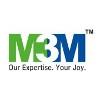
i
VTP
Realty
Filter interviews by
VTP Realty Interview Questions and Answers
17 Interview questions
Knowledge of IS codes is crucial for ensuring quality and safety in civil engineering projects.
IS codes provide standardized guidelines for materials, design, and construction practices.
For example, IS 456:2000 outlines the design and construction of reinforced concrete structures.
IS 3370 deals with the protection of concrete structures from water and chemical attack.
Understanding IS 800 is essential for designing...
Basic rate is the standard rate used for calculating the cost of construction materials and labor.
Basic rate is the rate which includes cost of materials, labor, and overhead expenses.
It is used as a base rate for calculating the total cost of a project.
Basic rate may vary depending on the location, type of project, and market conditions.
For example, the basic rate for cement in one region may be different from an...
Reinforcement steel wastage factor is the percentage of steel that is wasted during construction due to cutting, bending, and handling.
Reinforcement steel wastage factor typically ranges from 2-5% in construction projects.
Factors affecting wastage include the complexity of the design, skill of the workers, and quality of materials.
Proper planning and supervision can help minimize wastage and reduce costs.
For examp...
TDS (Tax Deducted at Source) is a tax collection mechanism in India where tax is deducted at the source of income.
TDS is governed by the Income Tax Act, 1961 in India.
It applies to various payments like salaries, interest, rent, and professional fees.
For example, if an employer pays an employee ₹50,000 as salary, they may deduct TDS based on the applicable rate.
Different sections of the Act specify different rates...
GST return filing dates vary by type; timely filing ensures compliance and avoids penalties.
GST returns are typically filed monthly or quarterly, depending on the taxpayer's turnover.
For monthly filers, the due date is usually the 20th of the following month.
Quarterly filers must submit their returns by the 22nd or 24th of the month following the quarter.
Example: For sales in January, a monthly filer must file by ...
Field tests on cement are conducted to ensure quality and performance.
Setting time test
Soundness test
Fineness test
Strength test
Consistency test
The order of activities in construction typically follows a sequence to ensure smooth progress and completion of the project.
Site preparation and clearing
Foundation work
Structural framing
Exterior finishing
Interior finishing
Final touches and landscaping
Bar bending schedule is calculated by determining the quantity of steel required for each bar in a structure.
Calculate the total length of each type of bar required in the structure
Determine the number of bends and shape of each bar
Calculate the total weight of steel required for each bar
Prepare a detailed schedule showing the dimensions, shape, and quantity of each bar
Use software like AutoCAD or Excel for accura...
Finishing quantity can be calculated by determining the area to be finished and the thickness of the finishing material.
Calculate the area to be finished by measuring the length and width of the surface.
Determine the thickness of the finishing material to be applied.
Multiply the area by the thickness to get the finishing quantity.
For example, if a wall is 10 feet long and 8 feet high, the area to be finished is 80...
The interviewee was asked about method of statement, SOP followed in past, and quality process followed.
For each activity, a detailed method of statement is prepared to ensure proper execution.
Standard Operating Procedures (SOPs) are followed to maintain consistency and efficiency.
A quality process is followed to ensure that the work meets the required standards and specifications.
Examples of quality processes inc...
VTP Realty Interview Experiences
38 interviews found
(2 Questions)
- Q1. What is Concept of basic rate?
- Ans.
Basic rate is the standard rate used for calculating the cost of construction materials and labor.
Basic rate is the rate which includes cost of materials, labor, and overhead expenses.
It is used as a base rate for calculating the total cost of a project.
Basic rate may vary depending on the location, type of project, and market conditions.
For example, the basic rate for cement in one region may be different from another...
- Q2. Reinforcement Steel Wastage factor?
- Ans.
Reinforcement steel wastage factor is the percentage of steel that is wasted during construction due to cutting, bending, and handling.
Reinforcement steel wastage factor typically ranges from 2-5% in construction projects.
Factors affecting wastage include the complexity of the design, skill of the workers, and quality of materials.
Proper planning and supervision can help minimize wastage and reduce costs.
For example, i...
I appeared for an interview in Apr 2025, where I was asked the following questions.
- Q1. What is the hazard? How many safety layers required to hires building?
- Q2. Why you want to join VTP Realty. What your target in next five years.
I applied via Walk-in and was interviewed in Nov 2024. There was 1 interview round.
(4 Questions)
- Q1. Introduce yourself
- Q2. Technical round
- Q3. Basic knowledge test
- Q4. HR introduction
Interview Preparation Tips
I appeared for an interview in Jan 2025.
(1 Question)
- Q1. It was about my experience and discussions
(2 Questions)
- Q1. Details about solar system
- Q2. Electrical flowchart
(1 Question)
- Q1. Family background
(2 Questions)
- Q1. Order Of Activities in Construction ?
- Ans.
The order of activities in construction typically follows a sequence to ensure smooth progress and completion of the project.
Site preparation and clearing
Foundation work
Structural framing
Exterior finishing
Interior finishing
Final touches and landscaping
- Q2. What Are The Field Test On Cement ?
- Ans.
Field tests on cement are conducted to ensure quality and performance.
Setting time test
Soundness test
Fineness test
Strength test
Consistency test
Front Office and Administration Executive Interview Questions & Answers
posted on 22 Mar 2025
I appeared for an interview in Feb 2025, where I was asked the following questions.
- Q1. Basic information
- Q2. Roles and responsibilities
- Q3. Educational details
I appeared for an interview in Dec 2024.
(1 Question)
- Q1. Normal questions about my experience
(1 Question)
- Q1. What are your experiences and what are my expectations
- Ans.
I have over 5 years of experience in sales, exceeding targets consistently. I am results-driven and customer-focused.
Over 5 years of sales experience
Consistently exceeded sales targets
Results-driven and customer-focused
Strong communication and negotiation skills
Normal questions on sales
Interview Preparation Tips
Top trending discussions






VTP Realty Interview FAQs
Some of the top questions asked at the VTP Realty interview -
The duration of VTP Realty interview process can vary, but typically it takes about less than 2 weeks to complete.
Tell us how to improve this page.
VTP Realty Interviews By Designations
- VTP Realty Purchase Executive Interview Questions
- VTP Realty Civil Engineer Interview Questions
- VTP Realty Estimation Engineer Interview Questions
- VTP Realty Sales Executive Interview Questions
- VTP Realty Senior Accountant Interview Questions
- VTP Realty Accountant Interview Questions
- VTP Realty Senior Engineer Interview Questions
- VTP Realty Marketing Manager Interview Questions
- Show more
Interview Questions for Popular Designations
Overall Interview Experience Rating
based on 46 interview experiences
Difficulty level
Duration
Interview Questions from Similar Companies
VTP Realty Reviews and Ratings
based on 313 reviews
Rating in categories
|
Assistant Manager
81
salaries
| ₹4.6 L/yr - ₹12 L/yr |
|
Senior Engineer
67
salaries
| ₹4.6 L/yr - ₹9 L/yr |
|
Sales Manager
52
salaries
| ₹3.6 L/yr - ₹12.2 L/yr |
|
CRM Executive
41
salaries
| ₹2.1 L/yr - ₹5.4 L/yr |
|
Senior Sales Executive
36
salaries
| ₹3.7 L/yr - ₹6 L/yr |

Knight Frank

M3M India

R.S. Infraprojects

My Home Constructions
- Home >
- Interviews >
- VTP Realty Interview Questions














